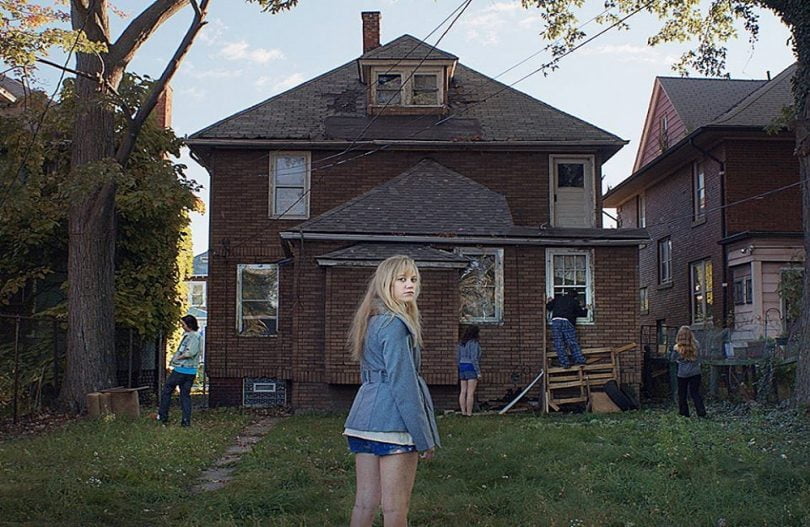The American suburb – with every fake glance, dull dinner party, and well-kept garden – is an ideal that’s too good to be true. Since the 1970s, the horror genre has exploited McCarthy’s twisted vision of a post-war utopia. Get Out comes in a long line of films that reveal, through a variety of sub-genres, what lies beneath the pretence of the ‘liberal’ well-to-do neighbourhood.
After WWII, the suburban project launched in response to the influx of war veterans and the “baby boom” of the 1960s. Targeting the middle classes, the project became a badge of honour, a means of assimilating into a humble, safe, and comfortable lifestyle. It was, and still is, a symbol of the modern American Dream.
But for John Carpenter, Wes Craven, and contemporary directors such as David Robert Mitchell, suburbia is not an ideal – it is an insidious, horrifying nightmare. Every neighbour has something terrible to hide, each household is collapsing beneath its pristine paintwork, and every smile masks resent.
Here are four films that track the trajectory of horror’s long obsession with suburbia.
The Stepford Wives (1975)
From the 50s onwards, women have been commodified as household objects, trapped in the artificial illusion of the ‘home’, and robbed of their freedom. The Stepford Wives sees photographer Joanna move from Manhattan to the quaint town of Stepford. After her husband joins a gentleman’s society, one by one her friends become all-smiling, penis-worshipping, cleaning machines.
[video:https://youtu.be/yh9yM00r9JQ]Director Bryan Forbes imagines Stepford as a melting pot of anxiety. Joanna’s quest to escape the suburban nightmare resembles the latent fears of the housewife, desperately clinging onto reality as her desires are moulded for her, like clay.
Halloween (1978)
This list wouldn’t be complete without Halloween, John Carpenter’s horror classic. It follows the story of Laurie, who is pursued by Michael Myers – a psychopath who returns to his hometown to kill again, over ten years after he murdered his sister. Myers’ identity is concealed behind a mask, his body never fully in frame, a phallic knife held out in front of him; he is a reflection of the protagonist’s anxieties, liberating Laurie of her household duties and breaching the home from within.
[video:https://youtu.be/xHuOtLTQ_1I]However, it is Myers’ therapist, Dr Loomis, who best encapsulates suburbia’s fallacy of security: he is acutely aware of the dangers that lie beneath the ordinary, viewing homes not as safe enclosures, but as hunting grounds for the weak.
It Follows (2014)
David Robert Mitchell’s coming-of-age tale doesn’t view the suburban nightmare through a 21st-century lens per se; its world is suspended in time – teenagers read Dostoyevsky on shell-shaped e-readers and TV relics play pre-50s horror. It focuses on Jay who, after a sexual encounter, is given the curse of a shape-shifting entity.
[video:https://youtu.be/Ymoh5SIqgtw]If it touches you, you die. If you run, it follows. But if you pass it on, the next victim will be cursed and you will be liberated. Part STI-satire, part teen drama, It Follows is an ambiguous creation; hundreds of interpretations could be attached to its B-movie narrative. Its depiction of an isolated suburbia infected with a chilling nightmare, imbued with melancholia, feels like something Arcade Fire would dream up if let loose with a Super 8 camera.
Get Out (2017)
The Stepford Wives, Halloween, and It Follows are all concerned with sexual politics – Stepford, in particular, manages to distill the ethos of second-wave feminism to thrilling effect. Get Out, Jonathan Peele’s directing debut, is concerned more with the politics of Obama’s post-racial America.
[video:https://youtu.be/DzfpyUB60YY]It sees Chris, an African-American man, visit his Caucasian girlfriend’s parents for the first time. He encounters cultural appropriation, stereotyping, and the ‘progressive’ politics of liberal America – “I would’ve voted for Obama for a third time”, insists her father. However, after Chris is hypnotised, we see the reality of what lies beneath this pretence – that social liberalism is, often, merely a disguise. Stepford, Halloween, and It Follows subtly break down the barrier between the imagined utopia and the ugly reality within.
With Get Out, the artifice of the suburb comes crashing down.









